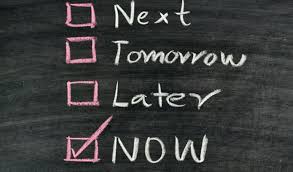HOW CAN I BECOME MORE EFFICIENT? PART 1
We all have a lot on our plate: There are targets to reach, projects to complete, clients to keep happy, and much more. At the same time, the number of channels through which we communicate has risen sharply in recent years. These are all parameters that make it difficult to carry out our tasks efficiently and effectively. Today and in my next blog, I would therefore like to introduce you to some well-known and surprising methods for self-management and time management.
Self-management and time management – this is a big topic and there are thousands of books offering advice on this subject. However, we simply don’t have time to read them. That is why I am focusing on this topic today and in my next blog. I want to introduce you to some methods that I find useful myself with the aim of helping you to work more efficiently and effectively and making life less stressful.
What are the main reasons why many of us struggle with this issue?
- Bad planning
- Using adequate periods of time in the wrong way, i.e. not setting the right priorities
- Chaotic working methods
- Forgetfulness
- Allow yourself to be constantly distracted
- Failure to define clear boundaries
However, good self-management and time management increase your productivity and also the quality of your work – with positive consequences: “Professional success and personal contentment are largely based on sensible time management”, says the German communication trainer Anette Kirsch. Of course, not all people are receptive to this topic. Some need the spontaneity and creativity of an unplanned agenda. But for most of us, self-management and time management bring structure to our daily lives and enhance our efficiency and effectiveness.
Planning and prioritization
To avoid taking up your limited time even further, I’ll now turn to these methods. In the first blog on this topic, I am focusing on planning and prioritization. There are various tools to help with this. I will introduce those that I find most worthwhile:
To-do lists: Make a to-do list and update it regularly.
Weekly or daily planning: Create a weekly or daily schedule – depending on the kind of job you do (longer-term tasks or projects that are constantly changing) or what suits you better. A daily schedule can be drawn up first thing in the morning or in the evening before leaving the workplace. Most of my coaching clients prefer the evening, as it gives them a relaxed feeling when they finish work because they have already decided what they are doing the next day. Plan only 60% of your time. The other 40% is for unplanned issues and for socializing. You should plan a maximum of two top priorities per day.
Plan blocks of time: Don’t look at your e-mails after every small task. Instead, you should set aside blocks of time for similar tasks, such as checking e-mails, administrative tasks or conceptual work, etc. These blocks should be entered in your calendar.
Uninterrupted periods: Set aside periods of time every week when you don’t want to be interrupted (e. g. for conceptual work). Redirect the phone, put up a ‘do not disturb’ sign or something similar if you work in an open-plan office, or – if possible – spent part of your time working from home (just as I am now writing this blog in my home office). If you are interrupted while you are working, it takes about 20 minutes to become fully focused again. And with continuous interruptions, you never get into a flow (release of the happiness hormone serotonin), which occurs when you can concentrate on something for longer.
Keep a record: Spend a few weeks writing down what you do and the amount of time you need to do it. You can then analyze this list and draw conclusions from it.
List your activities: List basically all the activities that you do, and – as recommended by the fascinating newsletter www.zeitzuleben.de (German only) – add the following abbreviations to the list (possibly several per activity): P= tiresome duty; ok=is ok, but more of it is not necessary; G=does me good and makes me happy; +=gives me strength; -= drains me of energy; w=important for me; u=important, I could avoid doing this without negative consequences. You then mark the individual activities with: a downward arrow = I want to do less of that; an upward arrow = I want to do more of that; strike through= I will avoid this activity altogether.
Getting things done: According to the approach defined by David Allen, all tasks should be recorded and then categorized based on their degree of urgency. Important tasks that can be completed in a very short space of time should all be performed immediately. That will make you feel good.
Eisenhower Matrix: General Eisenhower’s method involves dividing all tasks into four fields (according to their level of priority):
Urgent and important: DO IT: I have to do it myself immediately, e. g. crises, projects with strict deadlines, etc.
Important, but not urgent: PLAN IT: Set a deadline for completion. This will probably cover a large part of your tasks.
Not important, but urgent: DELEGATE: Get it done immediately (if you can).
Not important and not urgent: ELIMINATE IT: Get rid of tasks that waste time (more on this in the next blog) or simply dare to not do something.
These are questions that help with the Eisenhower Principle: 1) Why do it at all? 2) Why me? 3) Why in this form? 4) Why now?
Pareto Principle: The Pareto Principle works according to the 80/20 rule, which can be applied to many areas. For example, many companies generate 80% of their turnover with 20% of their clients. However, the Pareto Principle also applies to your work in general: 20% of your time is needed to achieve 80% of the result. Is it worth the 80% effort to get the remaining 20%? Some fine-tuning is certainly good, but not an entire 80%…
Salami tactics: Dividing large tasks into small subtasks. This makes the task more manageable and is less painful.
Personal performance curve: Everyone has their own personal performance curve with its highs and lows. Are you, for example, more of a morning or an evening person? Take this into account when planning your work. For most people, it also makes sense not to plan for anything that requires a lot of brainwork right after lunch, since your body needs energy to digest.
You may have the impression, because of this large list, that you won’t be able to work at all because you are too busy planning! Of course, you don’t have to use all of these methods but simply find the right one(s) for you – that is a very individual matter. They key thing is for you to then apply them regularly. Christian Schroff, a coach and author of the book ‘Karrierefibel’, has found that seven minutes of planning each day are enough to save one hour daily. Give it a try!
In my next blog on April 10, 2018, I will examine ways of dealing with time-consuming tasks and other ways of improving self-management and time management.
© Claudia Kraaz





